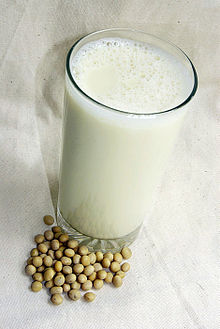Soy milk
 |
|||||||
| Alternative names | Soya milk | ||||||
|---|---|---|---|---|---|---|---|
| Place of origin | China | ||||||
| Invented | c. 1365 | ||||||
| 33 kcal (138 kJ) | |||||||
|
|||||||
| |
|||||||
| Protein | 2.86 g |
|---|---|
| Fat | 1.61 g |
| Carbohydrate | 1.74 g |
| Soy milk | |||||||||||||||||
| Chinese name | |||||||||||||||||
|---|---|---|---|---|---|---|---|---|---|---|---|---|---|---|---|---|---|
| Traditional Chinese | 豆漿 | ||||||||||||||||
| Simplified Chinese | 豆浆 | ||||||||||||||||
| Literal meaning | "bean purée" | ||||||||||||||||
|
|||||||||||||||||
| Korean name | |||||||||||||||||
| Hangul | 두유 | ||||||||||||||||
| Hanja | 豆乳 | ||||||||||||||||
| Literal meaning | "bean milk" | ||||||||||||||||
|
|||||||||||||||||
| Japanese name | |||||||||||||||||
| Kanji | 豆乳 | ||||||||||||||||
| Kana | とうにゅう | ||||||||||||||||
|
|||||||||||||||||
| Transcriptions | |
|---|---|
| Standard Mandarin | |
| Hanyu Pinyin | dòu jiāng |
| Wade–Giles | tou4 chiang1 |
| IPA | [tôu̯.tɕi̯áŋ] |
| Yue: Cantonese | |
| Yale Romanization | dauh jēung |
| Jyutping | dau6 zoeng1 |
| Transcriptions | |
|---|---|
| Revised Romanization | duyu |
| McCune–Reischauer | tuyu |
| Transcriptions | |
|---|---|
| Revised Hepburn | tōnyū |
Soy milk is a plant based drink produced by soaking dried soybeans and grinding them in water.
A traditional staple of East Asian cuisine, soy milk is a stable emulsion of oil, water and protein. Soy milk can be produced at home using a soy milk machine.
Soymilk (doujiang) originated in China, probably during the early Han dynasty (202 BCE to 9 CE), after the rotary millstone was introduced and became widely used to grind wheat. It did not become widely used in China until the 1800s, when it was discovered that extended heating made it taste better and easier to digest.
Soymilk was introduced to the US market by Vitasoy in 1979; the first domestic manufacturer of soymilk was Sunrich Food Group, which introduced its products in 1985.
There is a certain amount of confusion prevalent when it comes to beverages named soy beverage, soy drink or soy milk respectively. This is caused by several factors:
In a 100 ml (gram, g) serving, one commercial, nutrient-fortified brand of soy milk provides 80 calories from 4 g of carbohydrates, including 1 g of sugar, 4 g of fat and 7 g of protein. This processed soy milk contains appreciable levels of vitamin A, B vitamins and vitamin D in a range of 10 to 45% of the Daily Value, with calcium and magnesium also in significant content.
Soy milk flavor quality differs according to the cultivar of soy bean. Soy milk aroma, smoothness and thickness in the mouth, color and creamy appearance are considered desirable qualities, with favored sensory attributes associating with protein content, soluble solids, and oil content.
In a study of taste attributes, soy milk flavored with vanilla or sweet aromatic flavors and higher viscosity was preferred by most subjects, while dislike factors were bean or broth flavors. In another study, 54% of participants preferred the taste of cow's milk, while 27% preferred soy milk, with sweetness and cream qualities identified as important flavor preferences.
...
Wikipedia
